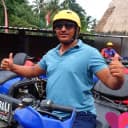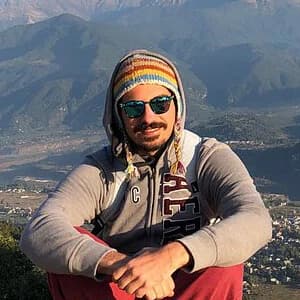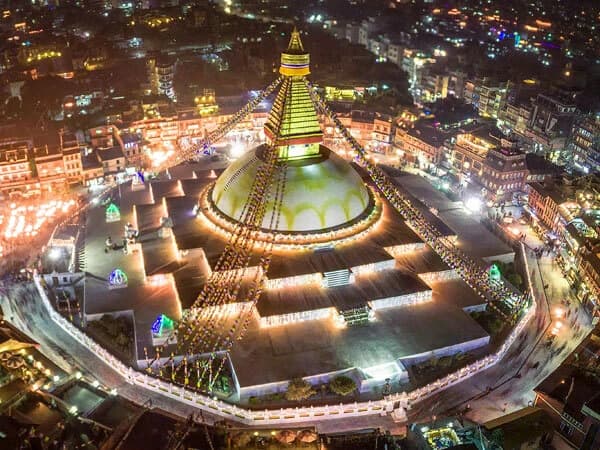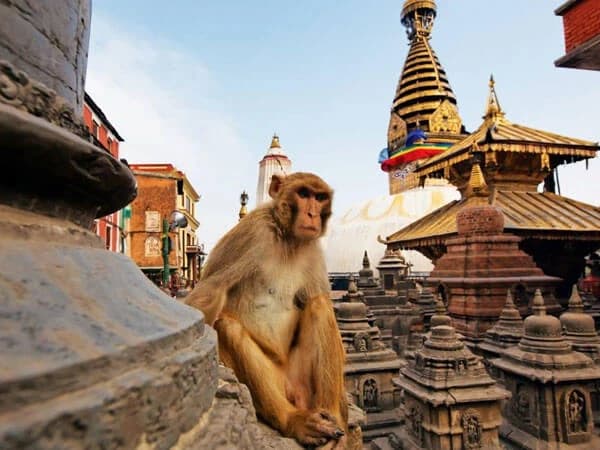Everset Base Camp Trek in Nepal - Ultimate Real Himalayan Adventure
The Everest Base Camp Trek is the crown jewel of trekking in Nepal, a legendary journey that draws adventurers from every corner of the globe. Known as one of the world’s most iconic treks, this route blends raw Himalayan landscapes, fascinating Sherpa culture, and the ultimate dream—standing at the foot of Mount Everest (8,848m), the highest mountain on Earth. More than just a trek, the EBC trek is a life-changing Himalayan adventure that rewards every step with breathtaking scenery and unforgettable memories.
Spanning roughly 130 kilometers round trip, the classic Everest trek begins with a thrilling Kathmandu to Lukla flight (2,840m)—one of the most scenic and adrenaline-filled flights in the world. From Lukla, the trail winds through the legendary Khumbu Valley, gradually ascending to allow for proper acclimatization. Along the way, trekkers cross dramatic suspension bridges draped with prayer flags, pass through traditional Sherpa villages, and enjoy jaw-dropping views of Everest, Lhotse, Nuptse, and Ama Dablam, some of the most iconic peaks in the Himalayas.
A major highlight of the trek to Everest Base Camp is the vibrant mountain town of Namche Bazaar, often called the “gateway to Everest.” This high-altitude hub buzzes with colorful markets, cozy teahouses, bakeries, and stunning panoramas of snow-covered peaks. Beyond Namche lies the tranquil Tengboche Monastery, a spiritual landmark framed by Everest and Ama Dablam. Many trekkers pause here, soaking in the peaceful chants of Buddhist monks while gazing at the Himalayan giants.
As the trail climbs higher, the landscape transforms—lush rhododendron forests give way to stark, glacial terrain, where icy rivers carve through the valley. The journey culminates at the legendary Everest Base Camp (5,364m), where climbers from across the world gather before attempting Everest summits. Standing here, surrounded by towering peaks, trekkers witness the raw power and beauty of the Himalayas. For an even greater spectacle, a short but steep hike to Kala Patthar (5,550m) offers the best panoramic view of Mount Everest, especially magical at sunrise when the peak glows golden against the sky.
The Everest Base Camp trek in Nepal is not just about landscapes—it is also about people and culture. Along the trail, trekkers experience authentic Sherpa hospitality, explore ancient monasteries, and learn about high-altitude traditions that have endured for centuries. Nights are spent in rustic mountain lodges and teahouses, where stories are shared around warm stoves after long trekking days.
A standard 14-day Everest Base Camp Trek itinerary remains the most popular, carefully designed with acclimatization days in Namche Bazaar and Dingboche. For those seeking comfort, luxury Everest Base Camp treks offer upgraded lodges and services. Adventurers with limited time can opt for a short Everest trek with helicopter return, while experienced trekkers can challenge themselves with extensions to the Gokyo Lakes trek or Everest Three High Passes trek. Each variation offers a unique flavor of Everest trekking, but all share the unparalleled thrill of reaching the base of the tallest mountain on Earth.
Whether you are a seasoned hiker or chasing your first Himalayan dream, the Everest Base Camp trek remains a bucket-list adventure that combines natural grandeur, cultural immersion, and the unforgettable reward of standing in the shadows of Everest itself.
Everest Base Camp Trek – Major Highlights
- Stand before the world’s tallest peak, Mount Everest (8,848.86m), the crown jewel of the Himalayas.
- Enjoy a thrilling scenic flight to Tenzing-Hillary Airport, Lukla, one of the most adventurous airports in the world.
- Reach the iconic Everest Base Camp (5,364m), a dream destination for adventure lovers.
- Witness the colossal Khumbu Glacier and Icefall, legendary features of Everest expeditions.
- Hike up to Kalapatthar (5,545m) for breathtaking panoramic views of Everest and the Khumbu Valley.
- Explore Namche Bazaar, the vibrant Himalayan trading hub with modern facilities at high altitude.
- Experience authentic Sherpa culture and visit the historic Tengboche Monastery, the spiritual heart of Khumbu.
- Visit the Sherpa Museum to understand the heroic mountaineering legacy of the Sherpa people.
- Short hike to the world-famous Hotel Everest View and explore Khumjung Village.
- Discover the UNESCO-listed Sagarmatha National Park, home to diverse flora, fauna, and stunning alpine scenery.
- Trek through authentic Sherpa villages, lush forests, and dramatic landscapes.
- Encounter rich Himalayan wildlife and colorful vegetation across different altitudes.
- Immerse yourself in unforgettable Himalayan vistas of Everest, Lhotse, Makalu, Ama Dablam, Nuptse, Pumori, Thamserku, Lingtren, Lobuche, Khangtenga, Tawache, Cholatse, and many other iconic peaks.
Everest Base Camp Trek – Explore Sherpa Culture & Himalayan Adventure
Embarking on the Everest Base Camp Trek is more than just a Himalayan adventure—it is an opportunity to immerse yourself in the inspiring lifestyle of the legendary Sherpa people. Known worldwide for their mountaineering skills and warm hospitality, the Sherpa community offers deep cultural insights that enrich your trekking experience. Along the trail, you will witness more than a dozen snow-capped Himalayan peaks, including the world’s tallest mountain, Mount Everest (8,848m), making this journey truly extraordinary.
This 14-day Everest Base Camp Trekking package is a once-in-a-lifetime journey that combines breathtaking landscapes, cultural exploration, and personal achievement. Every step towards Everest Base Camp provides lessons of resilience, inner strength, and unforgettable experiences in Nepal’s pristine Himalayan wilderness.
When travelers dream of a holiday in Nepal, the Himalayas and Everest Base Camp often top the list. Standing at the base of the highest mountain on earth has long been a bucket-list adventure for both thrill-seekers and nature enthusiasts. The Everest Base Camp Trek cost typically ranges between $1,355 to $2,700 per person, depending on the duration, itinerary, services, and level of comfort you choose.
Choosing the EBC Trek in Nepal not only fulfills your dream of witnessing Everest up close but also leaves you with lifelong memories of adventure, cultural encounters, and the unmatched beauty of the Himalayas.
Everest Base Camp Trek – Journey to the Foot of the World’s Highest Peak
The Everest Base Camp Trek is the ultimate Himalayan adventure and a dream for trekkers worldwide. Ideal even for beginners, this iconic trek takes you to an elevation of 5364 m, offering breathtaking views of Mount Everest, Lhotse, Nuptse, and Ama Dablam. Every step along the Everest trekking trail unveils majestic landscapes, vibrant Sherpa culture, and thrilling high-altitude experiences. A full acclimatization day at Namche Bazaar lets you immerse in Sherpa traditions before continuing toward the legendary base camp. For many adventurers, standing at the foot of the world’s tallest mountain is a lifelong achievement and a badge of honor. The Everest Base Camp hike is not just a trek—it’s a journey of cultural discovery, spiritual connection, and unforgettable rewards above the tree line in the mighty Himalayas.
Everest Base Camp Trek – The World’s Most Iconic Adventure
The Everest Base Camp Trek is a legendary Himalayan journey that blends adventure, culture, and jaw-dropping landscapes. Starting with a thrilling flight to Lukla, the trail passes through Phakding and into vibrant Namche Bazaar, the gateway to Everest. Along the way, trekkers enjoy warm Sherpa hospitality, monasteries, and breathtaking Himalayan views.
Reaching Everest Base Camp (5364m) is the ultimate reward, where the world’s tallest peaks surround you in majesty. In spring, the route buzzes with climbers preparing for their Everest ascent. An early morning hike to Kalapathar (5545m) offers the best sunrise views of Mount Everest, Lhotse, Nuptse, and Ama Dablam, leaving trekkers with memories to last a lifetime.
Is this Adventure Trip for You?
Are you ready for the adventure of a lifetime? The Everest Base Camp Trek is a challenging but rewarding journey, graded at level 5, ideal for those who are physically fit and seeking a true Himalayan adventure. Over 12 days, you will trek through Sherpa villages, cross iconic suspension bridges, and reach Everest Base Camp (5,364m) with a breathtaking climb to Kala Patthar (5,545m) for the best close-up views of Mount Everest. Spending a night at Gorakshep (5,180m), the world’s highest teahouse, is an unforgettable experience. Prior trekking experience or regular fitness training is recommended, along with preparation 1–2 months before your journey. With porter support, you carry only a light daypack, making this the ultimate Everest trekking adventure in Nepal.
How to Avoid Altitude Sickness During the Everest Base Camp Trek?
The Everest Base Camp Trek is one of the most iconic trekking adventures in Nepal, offering breathtaking Himalayan views and an unforgettable journey through Sherpa villages. However, due to the high altitude, proper preparation is essential. The trek reaches its highest point at Kala Patthar (5,545m), while the average elevation remains around 4,000 meters. To minimize the risk of altitude sickness on the EBC trek, we provide ample time for acclimatization and encourage trekkers to maintain good physical fitness. Having some previous trekking or hiking experience above 3,500 meters is highly recommended.
Walking hours mentioned in the Everest Base Camp hike itinerary are approximate and can vary depending on group pace, excluding lunch breaks. We always advise walking at a comfortable rhythm that suits your body, ensuring both safety and enjoyment.
The years 2025 and 2026 are considered ideal seasons for trekking in Nepal, with stable weather and clear mountain views. Our experienced local team is dedicated to guiding you through stunning landscapes and introducing you to the rich and unique Sherpa culture of the Everest region.
Join us for the Everest Base Camp adventure of a lifetime with Nepal High Trek & Expedition. With expert guidance and hassle-free arrangements, you can trek confidently to the base camp of the world’s tallest mountain.
Why Choose Real Adventure for Your Everest Base Camp Adventure?
Real Adventure is proud to be recognized as one of the best trekking agencies in Nepal for the Everest Base Camp Trek and other Himalayan adventures. With 17 years of experience and heartfelt recommendations from our valued clients, we are committed to delivering safe, authentic, and memorable journeys. Our itineraries are carefully designed by professional travel planners and local Sherpa guides, ensuring that every trekker receives genuine cultural insights and the best Himalayan experience. With a high success rate and a focus on client satisfaction, we guarantee excellent value for your investment. More than 70% of our trekkers return for another trip, reflecting our warm hospitality and expert trip management. Choosing us means a worry-free and rewarding Everest trekking holiday in the heart of the Himalayas.
Important Notes for Everest Treks
During peak trekking seasons (mid-September to November and March to May), all Kathmandu–Lukla flights are operated from Ramechhap Manthali Airport. We advise keeping an extra day as a buffer for possible flight delays or cancellations due to unpredictable mountain weather. While independent trekking is possible, traveling with a reliable agency ensures hassle-free logistics, quality accommodations, and greater safety. Please note that late bookings may limit the availability of preferred lodges and flights, so early reservations are recommended.




















